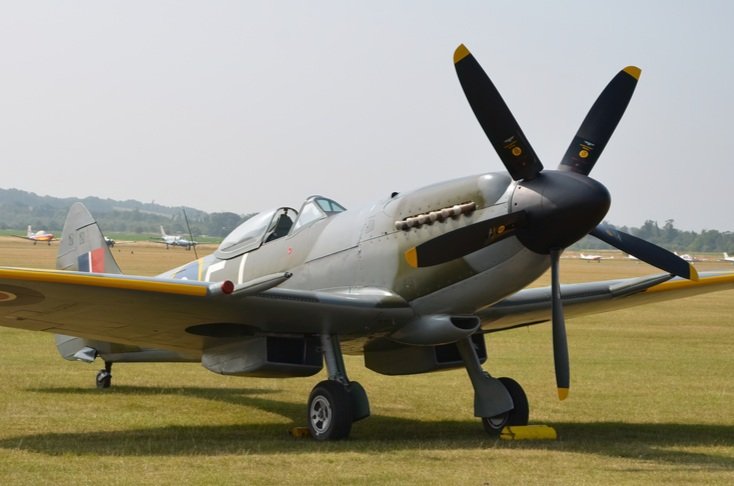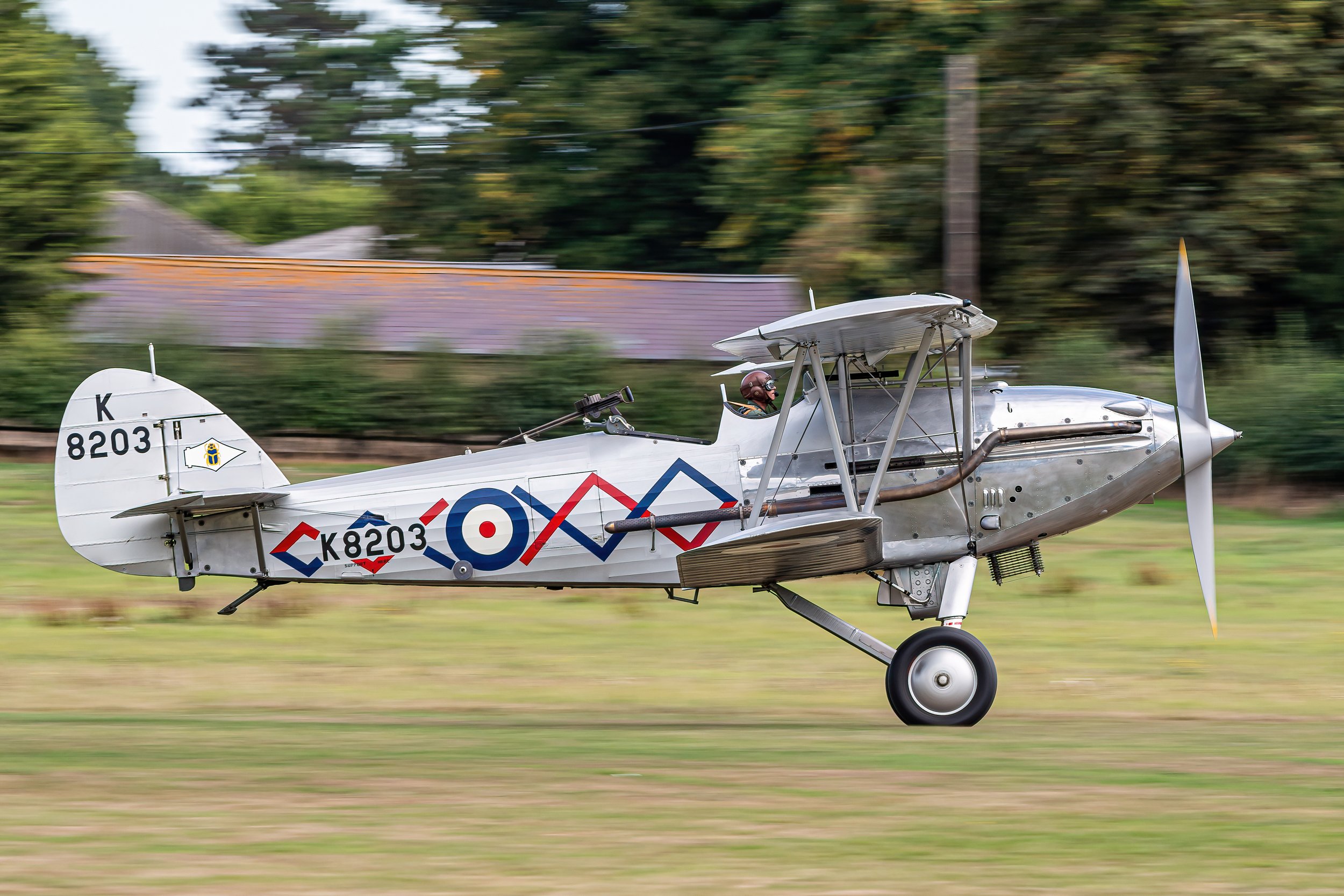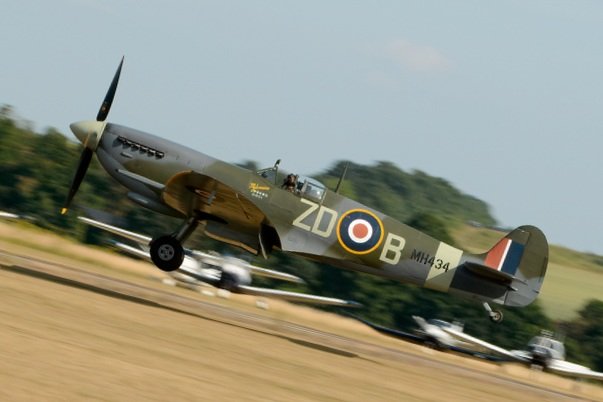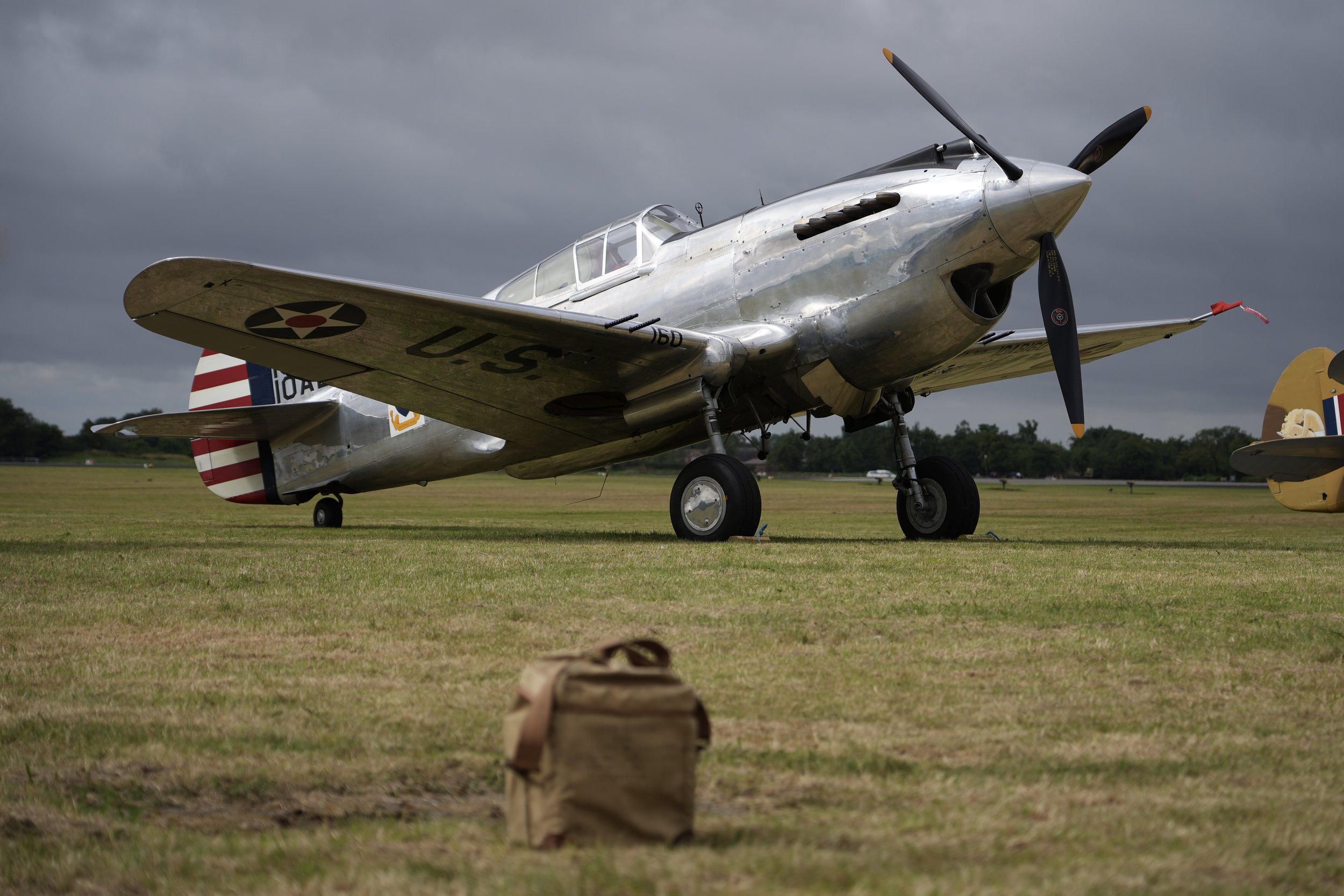Warhawk G-CIIO
Year built
1941
Aircraft
P-40C Warhawk
Base
Duxford Airfield
One of 2 P-40Cs acquired from the former Soviet Union in the 1990s by The Fighter Collection, 41-13357 was in much worse shape than the other (41-13390).
41-13357 was accepted by the USAAC on 6th April 1941, where it went on to serve at Patterson Field, Ohio. After recording around 100 hours there, it was shipped to Puerto Rico. While stationed there is presumed that this P-40C was used for coastal and anti-submarine patrols.
Having amassed 603 hours, it was returned to the Curtiss factory in Buffalo, New York, where it was overhauled for the Lend-Lease programme with the Soviet Union. The P-40C was then duly shipped to the USSR in December 1941. The history past this point is still relatively unknown.
During the restoration, it was decided to finish the aircraft in the scheme of a P-40 based at Chanute Field, Kansas. The aircraft wears the scheme of 39-159, a P-40C that was stripped of its olive drab camouflage paint and used as a personal ‘hack’ for base commanders.
The restoration culminated on the 5th August 2011 when aircraft (then registered N80FR) had its first post-restoration flight in the hands of Steve Hinton. The aircraft was shipped from Chino to Duxford during May/June 2014, in time for Flying Legends 2014 where it made its UK debut.
| Back to Top |
Curtiss P-40C Warhawk
The Curtiss P-40 Warhawk is an American single-engined, single-seat, all-metal fighter and ground-attack aircraft that first flew in 1938. The P-40 design was a modification of the previous Curtiss P-36 Hawk which reduced development time and enabled a rapid entry into production and operational service. The Warhawk was used by most Allied powers during World War II and remained in frontline service until the end of the war. It was the third most-produced American fighter of World War II, after the P-51 and P-47; by November 1944, when production of the P-40 ceased, 13,738 had been built, all at Curtiss-Wright Corporation's main production facilities at Buffalo, New York.
P-40 Warhawk was the name the United States Army Air Corps gave the plane, and after June 1941, the USAAF adopted the name for all models, making it the official name in the U.S. for all P-40s. The British Commonwealth and Soviet air forces used the name Tomahawk for models equivalent to the original P-40, P-40B, and P-40C, and the name Kittyhawk for models equivalent to the P-40D and all later variants.
P-40s first saw combat with the British Commonwealth squadrons of the Desert Air Force in the Middle East and North African campaigns, during June 1941. No. 112 Squadron Royal Air Force, was among the first to operate Tomahawks in North Africa and the unit was the first Allied military aviation unit to feature the "shark mouth" logo, copying similar markings on some Luftwaffe Messerschmitt Bf 110 twin-engine fighters.
The P-40's lack of a two-speed supercharger made it inferior to Luftwaffe fighters such as the Messerschmitt Bf 109 or the Focke-Wulf Fw 190 in high-altitude combat and it was rarely used in operations in Northwest Europe. However, between 1941 and 1944, the P-40 played a critical role with Allied air forces in three major theatres: North Africa, the Southwest Pacific, and China. It also had a significant role in the Middle East, Southeast Asia, Eastern Europe, Alaska and Italy. The P-40's performance at high altitudes was not as important in those theatres, where it served as an air superiority fighter, bomber escort and fighter-bomber. Although it gained a postwar reputation as a mediocre design, suitable only for close air support, more recent research including scrutiny of the records of individual Allied squadrons indicates that this was not the case: the P-40 performed surprisingly well as an air superiority fighter, at times suffering severe losses, but also inflicting a very heavy toll on enemy aircraft. Based on war-time victory claims, over 200 Allied fighter pilots from the UK, Australia, New Zealand, Canada, South Africa, the US and the Soviet Union became aces flying the P-40. These included at least 20 double aces, mostly over North Africa, China, Burma and India, the South-West Pacific and Eastern Europe. The P-40 offered the additional advantages of low cost and durability, which kept it in production as a ground-attack aircraft long after it was obsolescent as a fighter.
On 14 October 1938, Curtiss test pilot Edward Elliott flew the prototype XP-40 on its first flight in Buffalo. The XP-40 was the 10th production, Curtiss P-36 Hawk, with its Pratt & Whitney R-1830 Twin Wasp 14-cylinder air-cooled radial engine replaced at the direction of Chief Engineer Don R. Berlin by a liquid-cooled, supercharged Allison V-1710 V-12 engine. The first prototype placed the glycol coolant radiator in an underbelly position on the fighter, just aft of the wing's trailing edge. USAAC Fighter Projects Officer Lieutenant Benjamin S. Kelsey flew this prototype some 300 miles in 57 minutes, approximately 315 miles per hour (507 km/h). Hiding his disappointment, he told reporters that future versions would likely go 100 miles per hour (160 km/h) faster. Kelsey was interested in the Allison engine because it was sturdy and dependable, and it had a smooth, predictable power curve. The V-12 engine offered as much power as a radial engine but had a smaller frontal area and allowed a more streamlined cowl than an aircraft with a radial engine, promising a theoretical 5% increase in top speed.
Curtiss engineers worked to improve the XP-40's speed by moving the radiator forward in steps. Seeing little gain, Kelsey ordered the aircraft to be evaluated in a NACA wind tunnel to identify solutions for better aerodynamic qualities. From 28 March to 11 April 1939, the prototype was studied by NACA. Based on the data obtained, Curtiss moved the glycol coolant radiator forward to the chin; its new air scoop also accommodated the oil cooler air intake. Other improvements to the landing gear doors and the exhaust manifold combined to give the performance that was satisfactory to the USAAC. Without beneficial tail winds, Kelsey flew the XP-40 from Wright Field back to Curtiss's plant in Buffalo at an average speed of 354 mph (570 km/h). Further tests in December 1939 proved the fighter could reach 366 mph (589 km/h).
An unusual production feature was a special truck rig to speed delivery at the main Curtiss plant in Buffalo, New York. The rig moved the newly built P-40s in two main components, the main wing and the fuselage, the eight miles from the plant to the airport where the two units were mated for flight and delivery.
The P-40 was conceived as a pursuit aircraft and was agile at low and medium altitudes but suffered from a lack of power at higher altitudes. At medium and high speeds it was one of the tightest-turning early monoplane designs of the war, and it could outturn most opponents it faced in North Africa and the Russian Front. In the Pacific Theater, it was out-turned at lower speeds by the lightweight fighters A6M Zero and Nakajima Ki-43 "Oscar" which lacked the P-40's structural strength for high-speed hard turns. The American Volunteer Group Commander Claire Chennault advised against prolonged dog-fighting with the Japanese fighters due to speed reduction favouring the Japanese.
Allison's V-1710 engines produced 1,040 hp (780 kW) at sea level and 14,000 ft (4,300 m). This was not powerful compared with contemporary fighters, and the early P-40 variants' top speeds were only average. The single-stage, single-speed supercharger meant that the P-40 was a poor high-altitude fighter. Later versions, with 1,200 hp (890 kW) Allisons or more powerful 1,400 hp Packard Merlin engines were more capable. Climb performance was fair to poor, depending on the subtype. Dive acceleration was good and dive speed was excellent. The highest-scoring P-40 ace, Clive Caldwell (RAAF), who claimed 22 of his 28½ kills in the type, said that the P-40 had "almost no vices", although "it was a little difficult to control in terminal velocity". The P-40 had one of the fastest maximum dive speeds of any fighter of the early war period and good high-speed handling.
The P-40 tolerated harsh conditions and a variety of climates. Its semi-modular design was easy to maintain in the field. It lacked innovations such as boosted ailerons or automatic leading-edge slats, but its strong structure included a five-spar wing, which enabled P-40s to pull high-G turns and survive some mid-air collisions. Intentional ramming attacks against enemy aircraft were occasionally recorded as victories by the Desert Air Force and Soviet Air Forces. Caldwell said P-40s "would take a tremendous amount of punishment, violent aerobatics as well as enemy action". Operational range was good by early war standards and was almost double that of the Supermarine Spitfire or Messerschmitt Bf 109, although inferior to the Mitsubishi A6M Zero, Nakajima Ki-43 and Lockheed P-38 Lightning.
Caldwell found the P-40C Tomahawk's armament of two .50 in (12.7 mm) Browning AN/M2 "light-barrel" dorsal nose-mount synchronized machine guns and two.303 Browning machine guns in each wing to be inadequate. This was improved with the P-40D (Kittyhawk I) which abandoned the synchronized gun mounts and instead had two .50 in (12.7 mm) guns in each wing, although Caldwell still preferred the earlier Tomahawk in other respects. The D had armour around the engine and the cockpit, which enabled it to withstand considerable damage. This allowed Allied pilots in Asia and the Pacific to attack Japanese fighters head-on, rather than try to out-turn and out-climb their opponents. Late-model P-40s were well-armoured. Visibility was adequate, although hampered by a complex windscreen frame, and completely blocked to the rear in early models by a raised turtledeck. Poor ground visibility and relatively narrow landing gear track caused many losses on the ground.
Curtiss tested a follow-on design, the Curtiss XP-46, but it offered little improvement over newer P-40 models and was cancelled.
The P-40N was the final production model. The P-40N featured a stretched rear fuselage to counter the torque of the more powerful, late-war Allison engine, and the rear deck of the cockpit behind the pilot was cut down at a moderate slant to improve rearward visibility. A great deal of work was also done to try and eliminate excess weight to improve the Warhawk's climb rate. Early N production blocks dropped a .50 in (12.7 mm) gun from each wing, bringing the total back to four; later production blocks reintroduced it after complaints from units in the field. Supplied to Commonwealth air forces as the Kittyhawk Mk IV. A total of 553 P-40Ns were acquired by the Royal Australian Air Force, making it the variant most commonly used by the RAAF. Subvariants of the P-40N ranged widely in specialization from stripped down four-gun "hot rods" that could reach the highest top speeds of any production variant of the P-40 (up to 380 mph), to overweight types with all the extras intended for fighter-bombing or even training missions. The 15,000th P-40 was an N model decorated with the markings of 28 nations that had employed any of Curtiss-Wright's various aircraft products, not just P-40s. "These spectacular markings gave rise to the erroneous belief that the P-40 series had been used by all 28 countries." Since the P-40N was by 1944 used mainly as a ground attack aircraft in Europe, it was nicknamed B-40 by pilots.
| Back to Top |









| Back to Top |

































